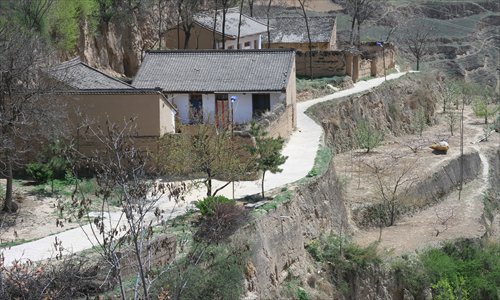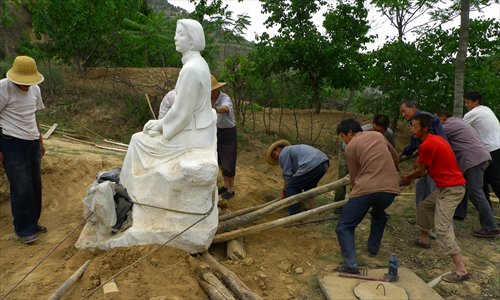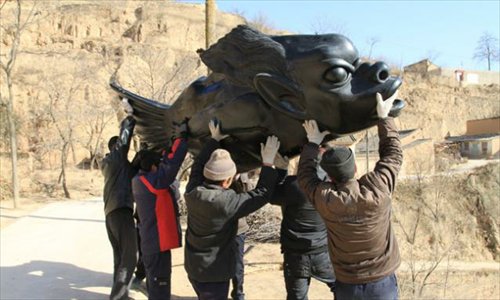Influenced by Ai Weiwei, a remote village evolves into a lab for performance artists
When villagers in Shijiezi in Gansu Province chose sculptor Jin Le as its village head, after a few went on a trip abroad sponsored by Ai Weiwei, changes started to occur in the poverty-stricken village. Jin turned the village into an art gallery and is also making the village a lab for activist artists.

A general view of Shijiezi village in Gansu Province. Photo: Courtesy of Jin Le
Li Songhua walked strenuously up the mountain, carrying Jin Shilin on his shoulders. It was midnight, and the two men were only wearing their underpants.
A car passed by, and when its headlights lit up the darkness, the driver was so shocked at the bizarre scene that he stalled the car. He soon restarted the engine and sped off in a hurry.
Li, an artist from Beijing, was carrying out a performance art project with Jin, a resident of the village of Shijiezi.
Weird scenes like this are not unusual in the small village these days, standing on an arid, terraced mountain slope to the north of Qin'an county, Gansu Province, an area known for its intensive sunshine, scant rainfall and desiccated mountains.
Only 13 earthen courtyard houses, each guarded by a street lamp, perch haphazardly on eight terraces - although villagers keep the lamps dark most of the time to save on electricity.
Higher up the hill is a small Taoist temple called the Golden Immortals Temple, where villagers pray for rain and good fortune. Lower down the hill, patches of peppercorn and fruit trees contend with the inhospitable soil, and as the villagers put it, the produce is largely depended on heaven's benevolence.
And that, really, was all the village had. Until recently. There was no hospital, no school, and not even a grocery store in the village. Villagers, however, were quite content and accepted things as they were. "We already eat wheat flour for every meal," Sun Liancheng, a Shijiezi farmer aged 79, said, "What more can we hope for?"
Certainly not a trip to Germany. So when Jin Le, a sculptor and Shijiezi native son who left the village in the 1980s, told villagers in 2007 that four of them would be able to visit Germany for free to get involved in an art project by Beijing artist Ai Weiwei, they were far from excited - everyone thought it was too good to be true.
Jin eventually convinced all the villagers, numbering about 60, to have a meeting, and the skeptical villagers chose four men go to Germany: Jin Nunu, then 60, Jin Maolin, 45, Li Baoyuan, 43, and Sun Baolin, 27. It was a trip that would change the entire village.

Villagers move a sculpture donated by Jin Le to the village. Photo: Courtesy of Jin Le
Fairytale come true
In 2007, Ai Weiwei brought 1,001 of his compatriots to Kassel, Germany to take part in an installation called "Fairytale." The 1,001 people, from different social classes in China, were living exhibits, even though they had no commitments during their stay and were free to visit anywhere they wanted as long as it was in Kassel.
The four villagers from Shijiezi applied for passports, took an airplane, and went abroad, all for the first time. When they visited Beijing to apply for visas, they brought Ai local peppers, pickles, peaches, and a silk banner that read "Gongde Wuliang," literally "endless merits and virtues," to show their gratitude.
In Kassel, what amazed them the most was not its exotic architecture, elegant gardens or art shows, but the rain. It hardly ever rains in Shijiezi. When the heavens opened, Jin Nunu couldn't help but gaze out of the glass window of the museum he was visiting. A German reporter asked him why he was so mesmerized. He said he hadn't seen a drop of rain in half a year.
"What is more important, art or rain?" the reporter asked.
"Art is important, but rain is even more important," Jin answered.
After the four men returned to Shijiezi, they became stars, and villagers bombarded them with questions about their trip to the distant European country. In Jin Nunu's home, a photograph of him with Ai Weiwei is framed and hung on the wall.
Ai, however, became a vocal critic of the Chinese government after the 2008 Wenchuan earthquake, and in 2011 he was detained for financial reasons, according to Chinese officials. After he was released, he was ordered to pay a 15 million yuan ($2.2 million) tax bill. The four villagers who went to Germany each donated 200 yuan to Ai. For them, it was as simple as returning a favor.
Jin Nunu opened his safe and carefully took out an envelope with his name in Chinese calligraphy. Inside the envelope was an ornately written IOU dated November 16, 2011. The IOU was written by Ai to every individual who helped him raise money.

Villagers move a sculpture donated by Jin Le to the village. Photo: Courtesy of Jin Le
Gallery village
Jin Le is the first university graduate that came out of this tiny village. Every Friday or Saturday, he leaves his home near Lanzhou's Northwest Normal University, where he teaches sculpture, "a marginalized course," and takes a four-hour bus to Qin'an county.
A year after the Germany trip, villagers elected Jin to be their village head. It's a nominal post - Shijiezi is too small to have its own administrative village committee and has to share one with over a dozen other villages. Since it's nominal, he isn't paid a salary.
Jin believes art can change the village into a better place. The first thing that he did was to turn Shijiezi into a huge art gallery. He delivered a dozen of his sculptures to the village and placed them at the entrance of the village, on each terrace, and on the mounds. There are experimental pieces, like a huge fish that has his face, with protruding eyes and an open mouth; some are more realistic, like a street vendor selling sweet potatoes to a kid. There's also a nude sculpture of a Greek goddess. The terraced slope is a natural exhibition space - all the statues can be seen clearly from a distance, without obstruction.
He filled the interior walls of the farmers' earthen homes with modern photography and photos of their Germany visit, photos of them gazing into the rain, squatting on the ground or looking out of the window of a plane. "Each house is now an exhibition hall," he said.
Jin also invited villagers to write the characters that spell "Shijiezi museum" in Chinese on a piece of paper, and uploaded the photographs online asking netizens to pick the handwriting that will be used as Shijiezi's logo. While literate villagers wrote the words, illiterate villagers drew the characters by imitating others. Netizens chose the handwriting of He Chunchun, Jin's mother. It is now carved into the mountain at the entrance of the village, accompanied by its English name written with twigs.
Waves of reporters and artists have come to the village, and the lonesome village, mainly made up of elderly people, women and children, suddenly became crowded. "More and more artists come, and the village is livelier than before," said 69-year-old Sun Yinyin.
"The streets are cleaner, and villagers are more outgoing when they see strangers. They know how to greet the artists," Li Baoyuan said.
That sparked the curiosity of township officials, who hadn't visited the village for years. In 2010, an official visited Shijiezi accompanied by a reporter, who fell down in the muddy streets. The official then sent several bags of cements to the village, asking them to pave the dirt roads.
The township government also sent 13 street lights to the village, and built a reservoir on the mountain in 2014 so that villagers had tap water for the first time - before, rainwater was their major water source.
Jin has tried hard to involve villagers in the art projects. In 2014, he was commissioned by a Chinese museum to do an installation called "Genetic sticks." He asked villagers to mix their hair with the village's red earth and make 150 terra-cotta sticks. For each stick, they earned 50 yuan. Gao Yonggui and her husband made 30 sticks, earning 1,500 yuan, a significant chunk of their income that year.
Artist activists
Under village head Jin Le, Shijiezi has become an art lab for artists to experiment with their performance art and express their understanding of China's rural society. And without knowing it, villagers are becoming the symbols of China's wealth gap, lack of rights, and poverty in the artists' works.
In his art project, Li carried farmer Jin Shilin from midnight to dawn. The artist wanted to invoke a sense of equality and empowerment in this region where people have few ways to make their voice heard by the powers that be.
This is just one project in the art program "Cooperation," which was launched last year by Jin Le and art studio Zao Space. Spanning a year, the project invites 25 artists to partner with 25 villagers and carry out art projects together.
Another artist, Liu Weiwei, noticed that the earthen walls of many houses are cracked, damaged by the massive Wenchuan earthquake in 2008. Villagers have no money to repair them, nor do they know how to report the problem to the government.
Liu took photographs of the cracks and went to the county government with Li Baoyuan to report the problems. He then invited his "Cooperation" partner Sun Yinyin to Beijing, and made a sculpture with deep crevices on it. "The crevices represent our cracked houses," Sun said.
Despite the artists' efforts to highlight poverty in the village and help the locals get richer, there is no sign the village will get out of poverty any time soon. Jin Le admitted their work had so far proved unsuccessful and plans to run a bed and breakfast business. To the villagers, getting rich through the performance arts is too good to be true.
Qin'an county, which administrates the village, has implemented several ways to alleviate poverty since China adopted a strategy of taking targeted measures to alleviate poverty. The county has been setting aside a bigger part of the budget and loans for poverty alleviation. In Kangpo village, 12 households got loans in 2015 and invested their money in local enterprises. It has proved much more effective to have a steady income than resorting to performance arts.
Newspaper headline: Arty farmers